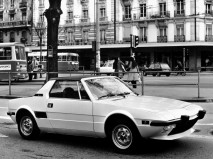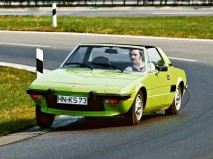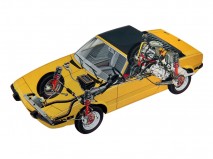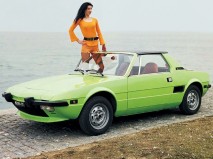1972 Fiat X1/9
The Fiat X1/9 is a two-seater mid-engined sports car designed by Bertone and manufactured by Fiat from 1972-1982 and subsequently by Bertone from 1982-1989. The X1/9 succeeded a 1969 show concept car called the Autobianchi Runabout, with styling by Bertone under chief designer Marcello Gandini. The Runabout was powered by the engine of the Autobianchi A112.
Designed around the all-new 128 SOHC engine and gearbox (transmission) from the front wheel drive Fiat 128, the X1/9 relocated the transverse drive train and suspension assembly from the front of the 128 to the rear of the passenger cabin, directly in front of the rear axle, giving a mid-engined layout. The layout also located the fuel tank and spare wheel side by side ahead of the engine, directly behind the seats — optimizing the proportion of the car's weight falling within its wheelbase for more effective handling and also enabling cargo areas front and rear.
The car was developed for release for European sales in 1972 to replace the 850 Spider by Bertone. It was not intended as a replacement for the 124 Sport Spider and production of the 124 Spider and X1/9 continued in parallel for much of the X1/9's life. The car's monocoque body was produced at the Bertone factory in Torino (Turin) and then transported to the Fiat's Lingotto factory for final assembly. In 1982, shortly after the introduction of the 1500 model, complete production was assumed by Bertone with models subsequently badged as the Bertone X1/9. Bertone models featured revised footwells redesigned to enhance legroom and sitting comfort for persons taller than the original design target.
The first models featured a 75 bhp (56 kW) 1290 cc single overhead cam engine with an aluminium head. The last production models were named the Gran Finale and sold over the 1989/1990 period. They were a dealer modification of the Special Edition (commonly abbreviated to SE) of 1988/1989, with the addition of a rear spoiler and Gran Finale badges.
Designed around the all-new 128 SOHC engine and gearbox (transmission) from the front wheel drive Fiat 128, the X1/9 relocated the transverse drive train and suspension assembly from the front of the 128 to the rear of the passenger cabin, directly in front of the rear axle, giving a mid-engined layout. The layout also located the fuel tank and spare wheel side by side ahead of the engine, directly behind the seats — optimizing the proportion of the car's weight falling within its wheelbase for more effective handling and also enabling cargo areas front and rear.
The car was developed for release for European sales in 1972 to replace the 850 Spider by Bertone. It was not intended as a replacement for the 124 Sport Spider and production of the 124 Spider and X1/9 continued in parallel for much of the X1/9's life. The car's monocoque body was produced at the Bertone factory in Torino (Turin) and then transported to the Fiat's Lingotto factory for final assembly. In 1982, shortly after the introduction of the 1500 model, complete production was assumed by Bertone with models subsequently badged as the Bertone X1/9. Bertone models featured revised footwells redesigned to enhance legroom and sitting comfort for persons taller than the original design target.
The first models featured a 75 bhp (56 kW) 1290 cc single overhead cam engine with an aluminium head. The last production models were named the Gran Finale and sold over the 1989/1990 period. They were a dealer modification of the Special Edition (commonly abbreviated to SE) of 1988/1989, with the addition of a rear spoiler and Gran Finale badges.



















